Marketing Across Cultures: UNIQLO's Cross-Cultural Analysis in UAE
VerifiedAdded on 2023/01/18
|12
|3544
|35
Report
AI Summary
This report presents a cross-cultural analysis of UNIQLO's marketing strategies, focusing on its expansion into the UAE market. The introduction highlights the importance of understanding cultural differences and provides an overview of the project's objectives. The report delves into the Hofstede cultural model, comparing Japan and the UAE across dimensions like individualism/collectivism, masculinity/femininity, and uncertainty avoidance. These cultural differences are then related to the marketing mix, with specific recommendations for product, price, promotion, and place strategies. The report suggests that UNIQLO should adapt its product offerings to include ethnic wear, adjust pricing to target a specific market segment, leverage digital promotion, and utilize online sales channels. The conclusion summarizes the key findings and emphasizes the need for UNIQLO to tailor its approach to the UAE's cultural context for successful market entry. The report provides insights into market entry strategies, emphasizing the importance of understanding cultural nuances and adapting marketing strategies to suit the local environment.
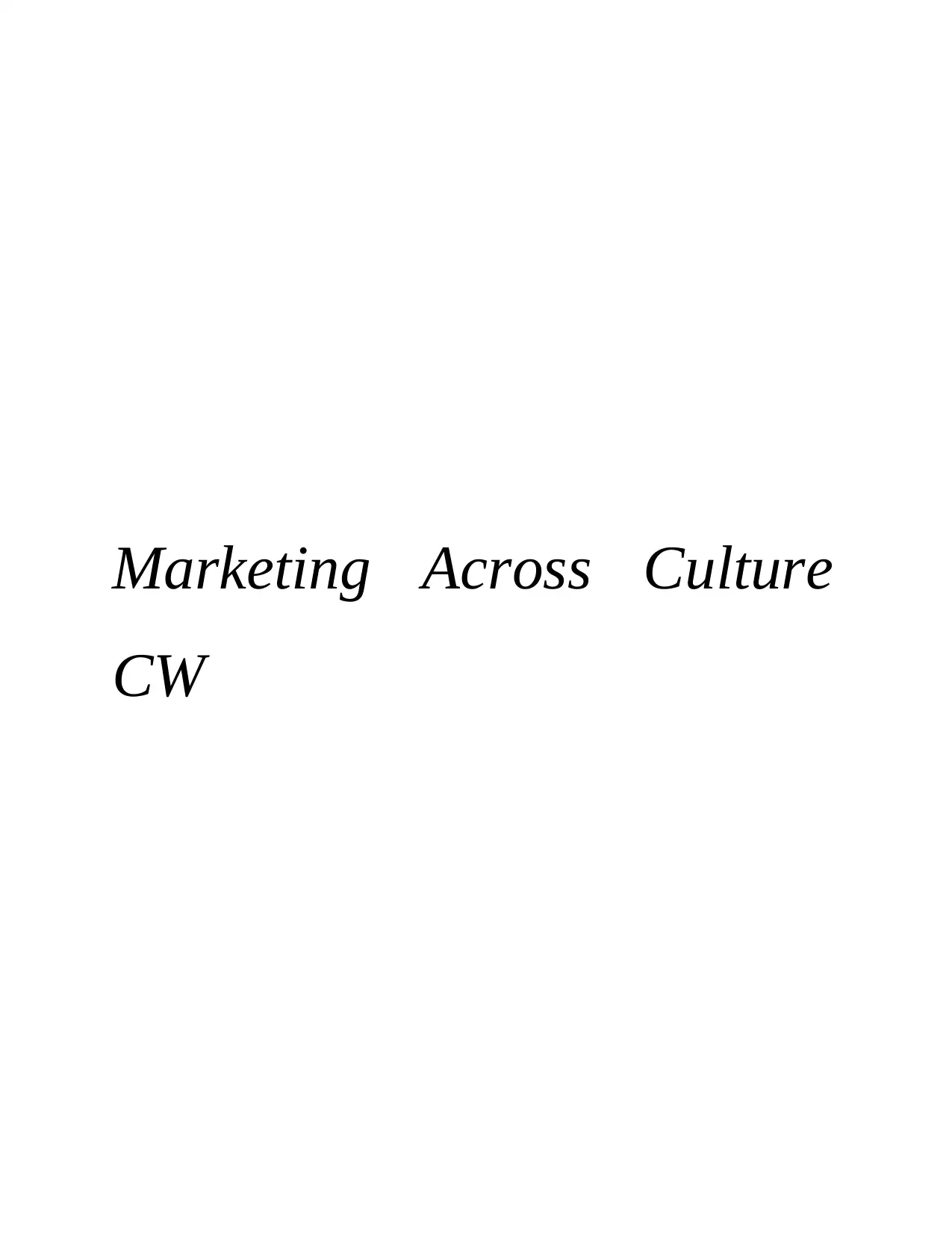
Marketing Across Culture
CW
CW
Paraphrase This Document
Need a fresh take? Get an instant paraphrase of this document with our AI Paraphraser
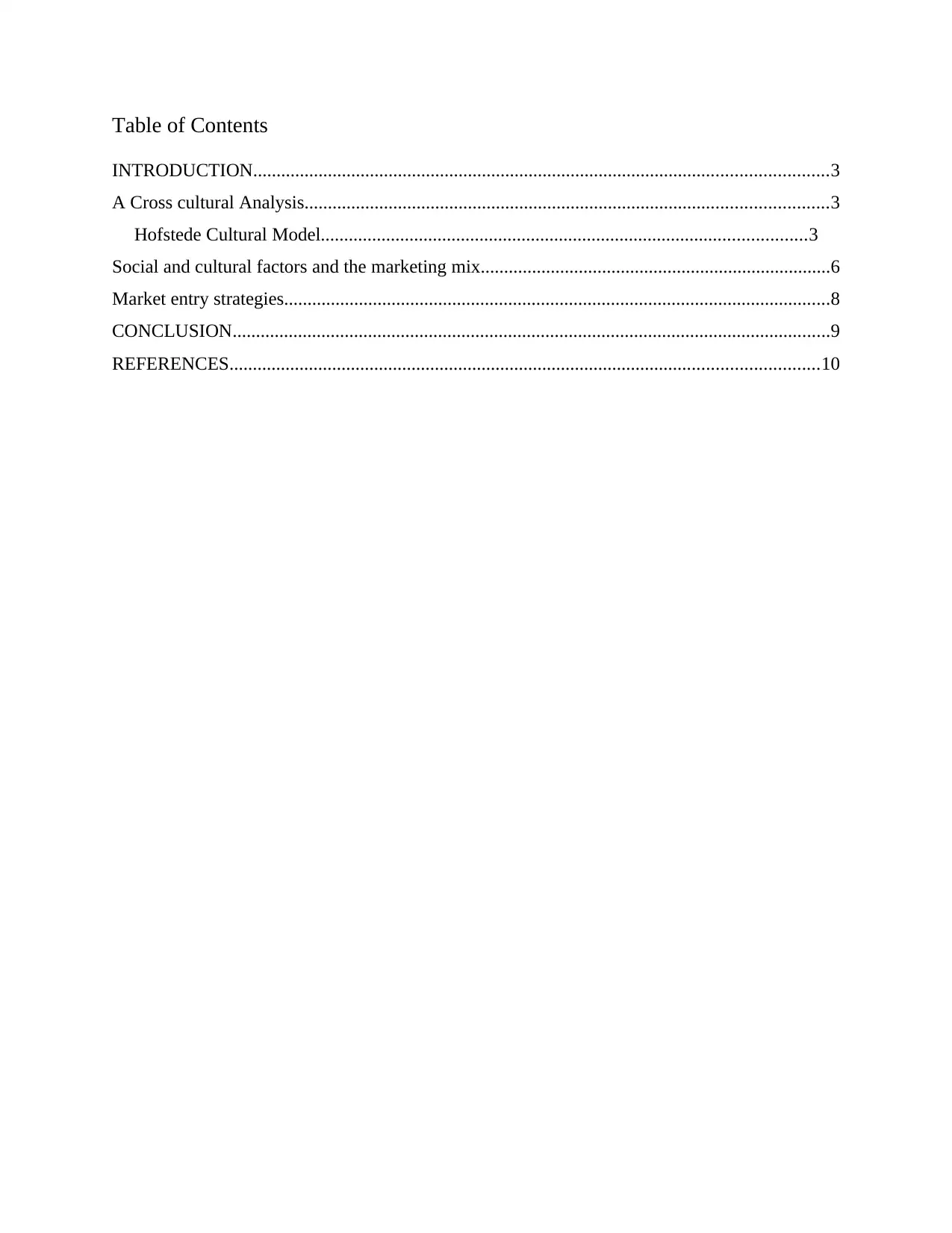
Table of Contents
INTRODUCTION...........................................................................................................................3
A Cross cultural Analysis................................................................................................................3
Hofstede Cultural Model........................................................................................................3
Social and cultural factors and the marketing mix...........................................................................6
Market entry strategies.....................................................................................................................8
CONCLUSION................................................................................................................................9
REFERENCES..............................................................................................................................10
INTRODUCTION...........................................................................................................................3
A Cross cultural Analysis................................................................................................................3
Hofstede Cultural Model........................................................................................................3
Social and cultural factors and the marketing mix...........................................................................6
Market entry strategies.....................................................................................................................8
CONCLUSION................................................................................................................................9
REFERENCES..............................................................................................................................10
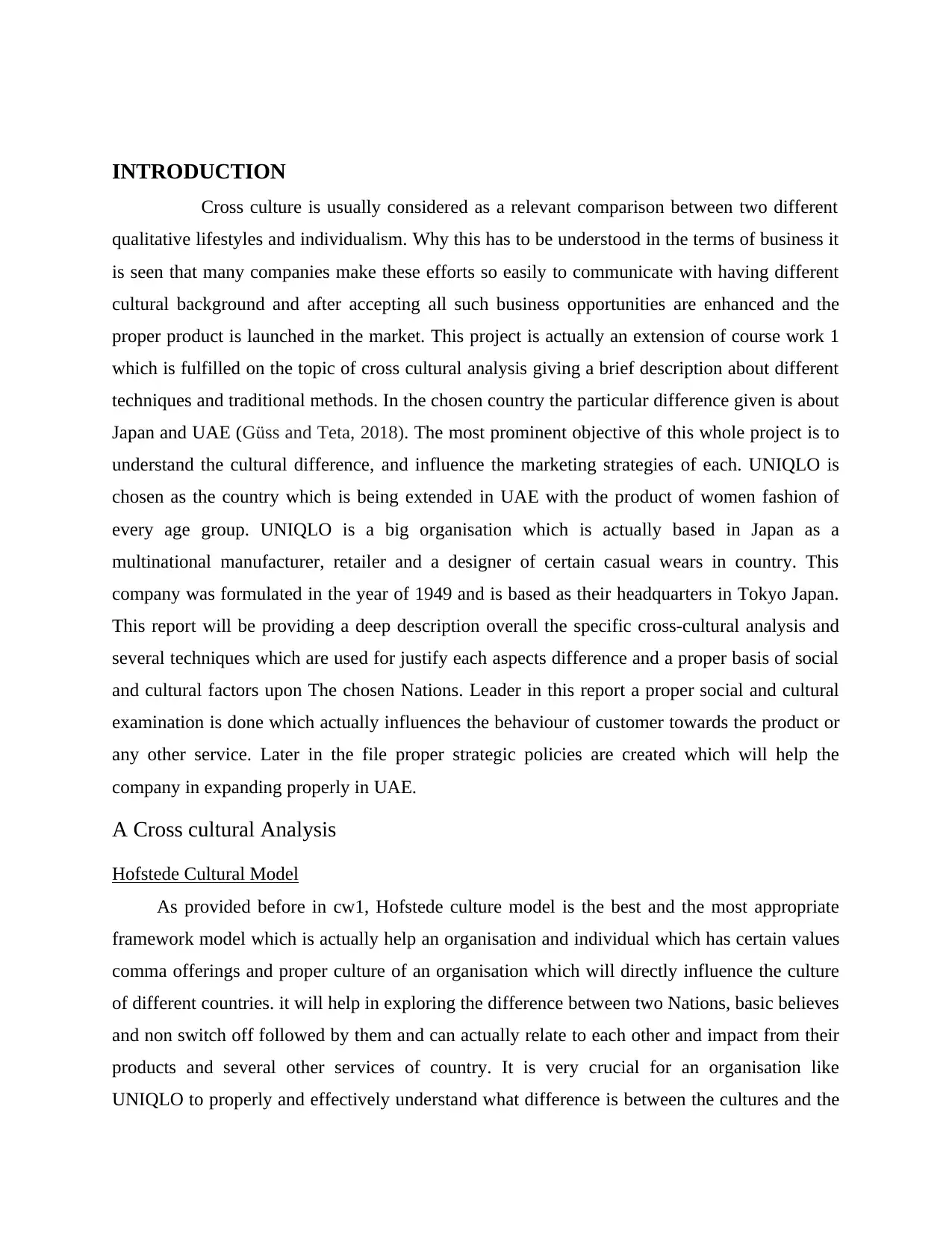
INTRODUCTION
Cross culture is usually considered as a relevant comparison between two different
qualitative lifestyles and individualism. Why this has to be understood in the terms of business it
is seen that many companies make these efforts so easily to communicate with having different
cultural background and after accepting all such business opportunities are enhanced and the
proper product is launched in the market. This project is actually an extension of course work 1
which is fulfilled on the topic of cross cultural analysis giving a brief description about different
techniques and traditional methods. In the chosen country the particular difference given is about
Japan and UAE (Güss and Teta, 2018). The most prominent objective of this whole project is to
understand the cultural difference, and influence the marketing strategies of each. UNIQLO is
chosen as the country which is being extended in UAE with the product of women fashion of
every age group. UNIQLO is a big organisation which is actually based in Japan as a
multinational manufacturer, retailer and a designer of certain casual wears in country. This
company was formulated in the year of 1949 and is based as their headquarters in Tokyo Japan.
This report will be providing a deep description overall the specific cross-cultural analysis and
several techniques which are used for justify each aspects difference and a proper basis of social
and cultural factors upon The chosen Nations. Leader in this report a proper social and cultural
examination is done which actually influences the behaviour of customer towards the product or
any other service. Later in the file proper strategic policies are created which will help the
company in expanding properly in UAE.
A Cross cultural Analysis
Hofstede Cultural Model
As provided before in cw1, Hofstede culture model is the best and the most appropriate
framework model which is actually help an organisation and individual which has certain values
comma offerings and proper culture of an organisation which will directly influence the culture
of different countries. it will help in exploring the difference between two Nations, basic believes
and non switch off followed by them and can actually relate to each other and impact from their
products and several other services of country. It is very crucial for an organisation like
UNIQLO to properly and effectively understand what difference is between the cultures and the
Cross culture is usually considered as a relevant comparison between two different
qualitative lifestyles and individualism. Why this has to be understood in the terms of business it
is seen that many companies make these efforts so easily to communicate with having different
cultural background and after accepting all such business opportunities are enhanced and the
proper product is launched in the market. This project is actually an extension of course work 1
which is fulfilled on the topic of cross cultural analysis giving a brief description about different
techniques and traditional methods. In the chosen country the particular difference given is about
Japan and UAE (Güss and Teta, 2018). The most prominent objective of this whole project is to
understand the cultural difference, and influence the marketing strategies of each. UNIQLO is
chosen as the country which is being extended in UAE with the product of women fashion of
every age group. UNIQLO is a big organisation which is actually based in Japan as a
multinational manufacturer, retailer and a designer of certain casual wears in country. This
company was formulated in the year of 1949 and is based as their headquarters in Tokyo Japan.
This report will be providing a deep description overall the specific cross-cultural analysis and
several techniques which are used for justify each aspects difference and a proper basis of social
and cultural factors upon The chosen Nations. Leader in this report a proper social and cultural
examination is done which actually influences the behaviour of customer towards the product or
any other service. Later in the file proper strategic policies are created which will help the
company in expanding properly in UAE.
A Cross cultural Analysis
Hofstede Cultural Model
As provided before in cw1, Hofstede culture model is the best and the most appropriate
framework model which is actually help an organisation and individual which has certain values
comma offerings and proper culture of an organisation which will directly influence the culture
of different countries. it will help in exploring the difference between two Nations, basic believes
and non switch off followed by them and can actually relate to each other and impact from their
products and several other services of country. It is very crucial for an organisation like
UNIQLO to properly and effectively understand what difference is between the cultures and the
⊘ This is a preview!⊘
Do you want full access?
Subscribe today to unlock all pages.

Trusted by 1+ million students worldwide
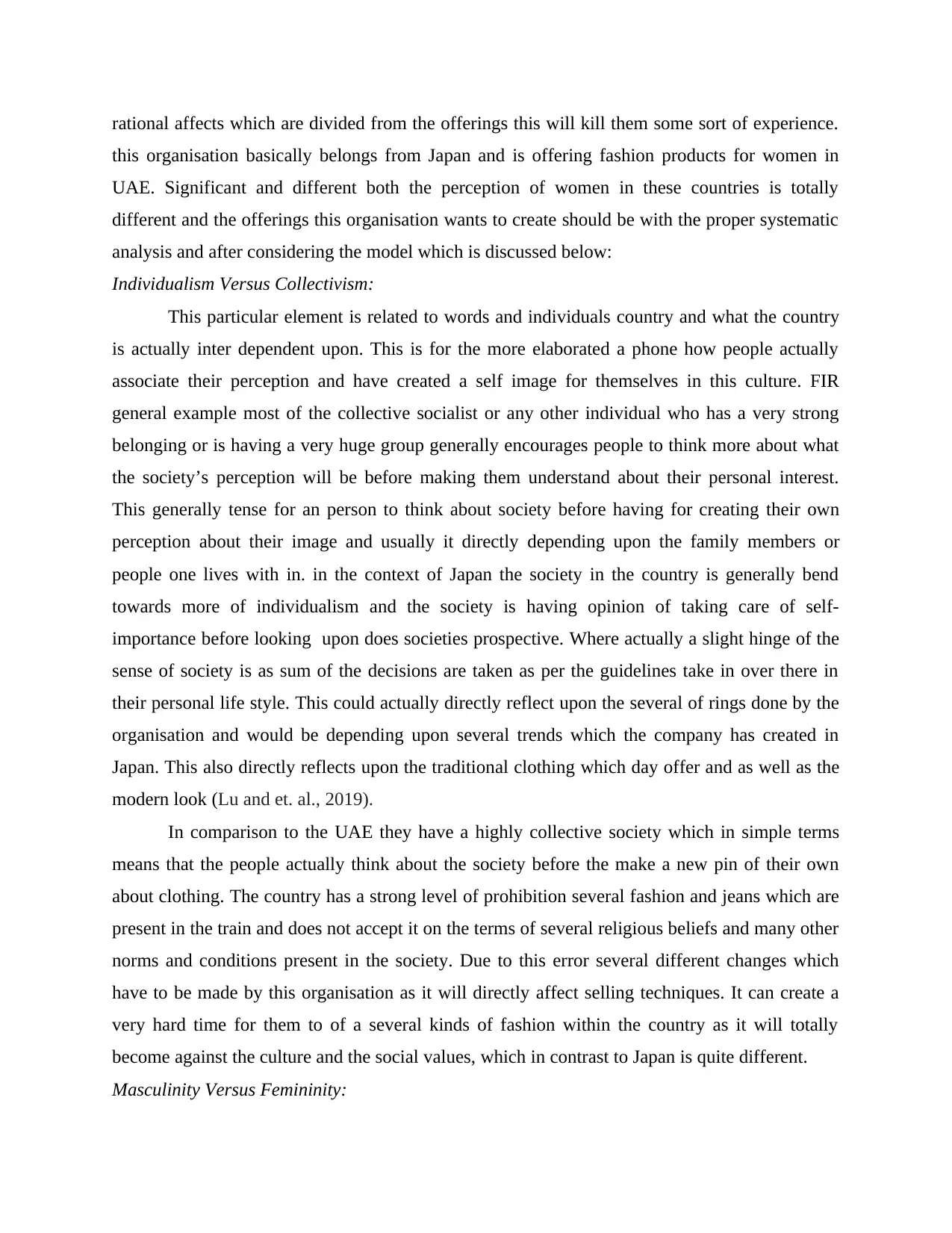
rational affects which are divided from the offerings this will kill them some sort of experience.
this organisation basically belongs from Japan and is offering fashion products for women in
UAE. Significant and different both the perception of women in these countries is totally
different and the offerings this organisation wants to create should be with the proper systematic
analysis and after considering the model which is discussed below:
Individualism Versus Collectivism:
This particular element is related to words and individuals country and what the country
is actually inter dependent upon. This is for the more elaborated a phone how people actually
associate their perception and have created a self image for themselves in this culture. FIR
general example most of the collective socialist or any other individual who has a very strong
belonging or is having a very huge group generally encourages people to think more about what
the society’s perception will be before making them understand about their personal interest.
This generally tense for an person to think about society before having for creating their own
perception about their image and usually it directly depending upon the family members or
people one lives with in. in the context of Japan the society in the country is generally bend
towards more of individualism and the society is having opinion of taking care of self-
importance before looking upon does societies prospective. Where actually a slight hinge of the
sense of society is as sum of the decisions are taken as per the guidelines take in over there in
their personal life style. This could actually directly reflect upon the several of rings done by the
organisation and would be depending upon several trends which the company has created in
Japan. This also directly reflects upon the traditional clothing which day offer and as well as the
modern look (Lu and et. al., 2019).
In comparison to the UAE they have a highly collective society which in simple terms
means that the people actually think about the society before the make a new pin of their own
about clothing. The country has a strong level of prohibition several fashion and jeans which are
present in the train and does not accept it on the terms of several religious beliefs and many other
norms and conditions present in the society. Due to this error several different changes which
have to be made by this organisation as it will directly affect selling techniques. It can create a
very hard time for them to of a several kinds of fashion within the country as it will totally
become against the culture and the social values, which in contrast to Japan is quite different.
Masculinity Versus Femininity:
this organisation basically belongs from Japan and is offering fashion products for women in
UAE. Significant and different both the perception of women in these countries is totally
different and the offerings this organisation wants to create should be with the proper systematic
analysis and after considering the model which is discussed below:
Individualism Versus Collectivism:
This particular element is related to words and individuals country and what the country
is actually inter dependent upon. This is for the more elaborated a phone how people actually
associate their perception and have created a self image for themselves in this culture. FIR
general example most of the collective socialist or any other individual who has a very strong
belonging or is having a very huge group generally encourages people to think more about what
the society’s perception will be before making them understand about their personal interest.
This generally tense for an person to think about society before having for creating their own
perception about their image and usually it directly depending upon the family members or
people one lives with in. in the context of Japan the society in the country is generally bend
towards more of individualism and the society is having opinion of taking care of self-
importance before looking upon does societies prospective. Where actually a slight hinge of the
sense of society is as sum of the decisions are taken as per the guidelines take in over there in
their personal life style. This could actually directly reflect upon the several of rings done by the
organisation and would be depending upon several trends which the company has created in
Japan. This also directly reflects upon the traditional clothing which day offer and as well as the
modern look (Lu and et. al., 2019).
In comparison to the UAE they have a highly collective society which in simple terms
means that the people actually think about the society before the make a new pin of their own
about clothing. The country has a strong level of prohibition several fashion and jeans which are
present in the train and does not accept it on the terms of several religious beliefs and many other
norms and conditions present in the society. Due to this error several different changes which
have to be made by this organisation as it will directly affect selling techniques. It can create a
very hard time for them to of a several kinds of fashion within the country as it will totally
become against the culture and the social values, which in contrast to Japan is quite different.
Masculinity Versus Femininity:
Paraphrase This Document
Need a fresh take? Get an instant paraphrase of this document with our AI Paraphraser
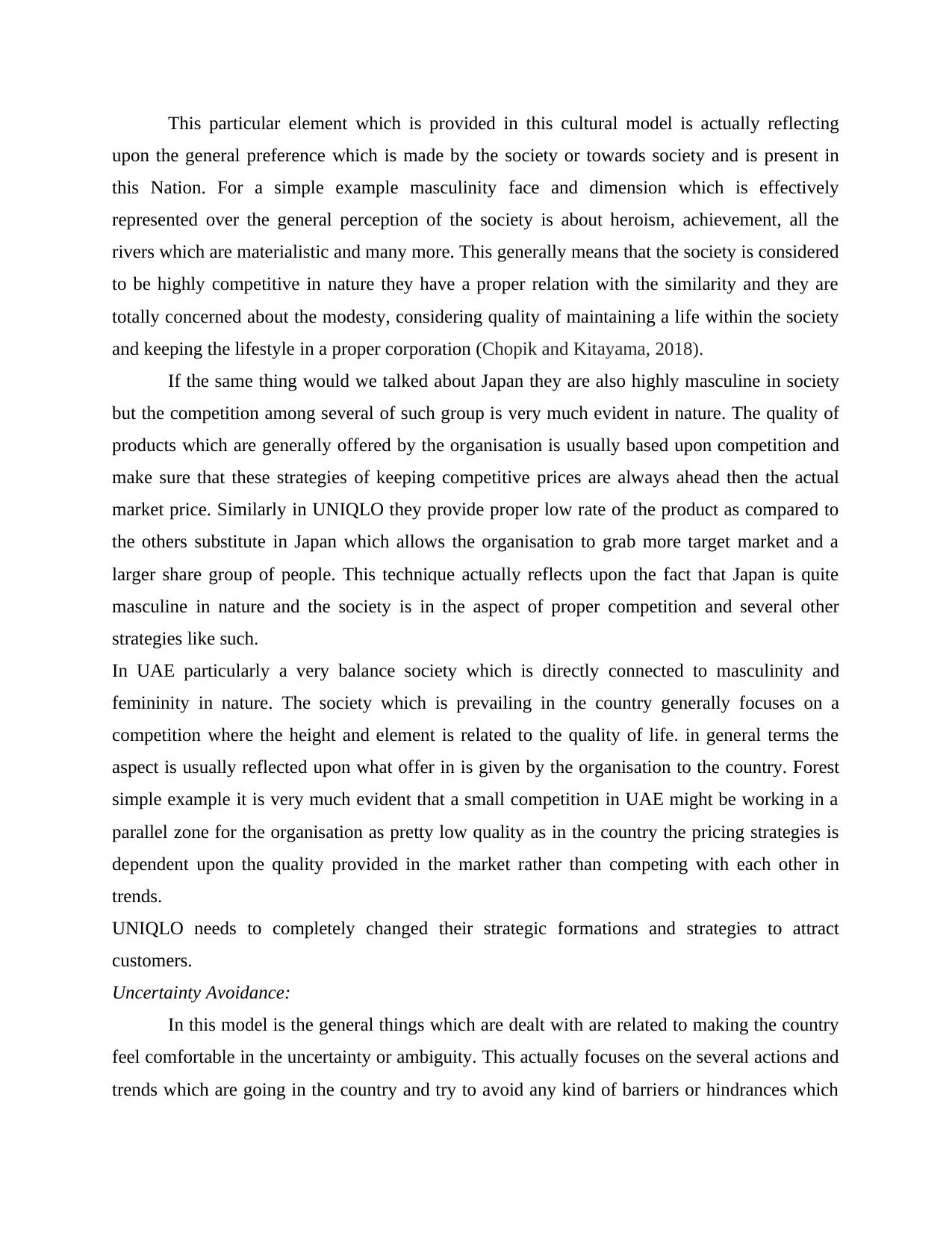
This particular element which is provided in this cultural model is actually reflecting
upon the general preference which is made by the society or towards society and is present in
this Nation. For a simple example masculinity face and dimension which is effectively
represented over the general perception of the society is about heroism, achievement, all the
rivers which are materialistic and many more. This generally means that the society is considered
to be highly competitive in nature they have a proper relation with the similarity and they are
totally concerned about the modesty, considering quality of maintaining a life within the society
and keeping the lifestyle in a proper corporation (Chopik and Kitayama, 2018).
If the same thing would we talked about Japan they are also highly masculine in society
but the competition among several of such group is very much evident in nature. The quality of
products which are generally offered by the organisation is usually based upon competition and
make sure that these strategies of keeping competitive prices are always ahead then the actual
market price. Similarly in UNIQLO they provide proper low rate of the product as compared to
the others substitute in Japan which allows the organisation to grab more target market and a
larger share group of people. This technique actually reflects upon the fact that Japan is quite
masculine in nature and the society is in the aspect of proper competition and several other
strategies like such.
In UAE particularly a very balance society which is directly connected to masculinity and
femininity in nature. The society which is prevailing in the country generally focuses on a
competition where the height and element is related to the quality of life. in general terms the
aspect is usually reflected upon what offer in is given by the organisation to the country. Forest
simple example it is very much evident that a small competition in UAE might be working in a
parallel zone for the organisation as pretty low quality as in the country the pricing strategies is
dependent upon the quality provided in the market rather than competing with each other in
trends.
UNIQLO needs to completely changed their strategic formations and strategies to attract
customers.
Uncertainty Avoidance:
In this model is the general things which are dealt with are related to making the country
feel comfortable in the uncertainty or ambiguity. This actually focuses on the several actions and
trends which are going in the country and try to avoid any kind of barriers or hindrances which
upon the general preference which is made by the society or towards society and is present in
this Nation. For a simple example masculinity face and dimension which is effectively
represented over the general perception of the society is about heroism, achievement, all the
rivers which are materialistic and many more. This generally means that the society is considered
to be highly competitive in nature they have a proper relation with the similarity and they are
totally concerned about the modesty, considering quality of maintaining a life within the society
and keeping the lifestyle in a proper corporation (Chopik and Kitayama, 2018).
If the same thing would we talked about Japan they are also highly masculine in society
but the competition among several of such group is very much evident in nature. The quality of
products which are generally offered by the organisation is usually based upon competition and
make sure that these strategies of keeping competitive prices are always ahead then the actual
market price. Similarly in UNIQLO they provide proper low rate of the product as compared to
the others substitute in Japan which allows the organisation to grab more target market and a
larger share group of people. This technique actually reflects upon the fact that Japan is quite
masculine in nature and the society is in the aspect of proper competition and several other
strategies like such.
In UAE particularly a very balance society which is directly connected to masculinity and
femininity in nature. The society which is prevailing in the country generally focuses on a
competition where the height and element is related to the quality of life. in general terms the
aspect is usually reflected upon what offer in is given by the organisation to the country. Forest
simple example it is very much evident that a small competition in UAE might be working in a
parallel zone for the organisation as pretty low quality as in the country the pricing strategies is
dependent upon the quality provided in the market rather than competing with each other in
trends.
UNIQLO needs to completely changed their strategic formations and strategies to attract
customers.
Uncertainty Avoidance:
In this model is the general things which are dealt with are related to making the country
feel comfortable in the uncertainty or ambiguity. This actually focuses on the several actions and
trends which are going in the country and try to avoid any kind of barriers or hindrances which
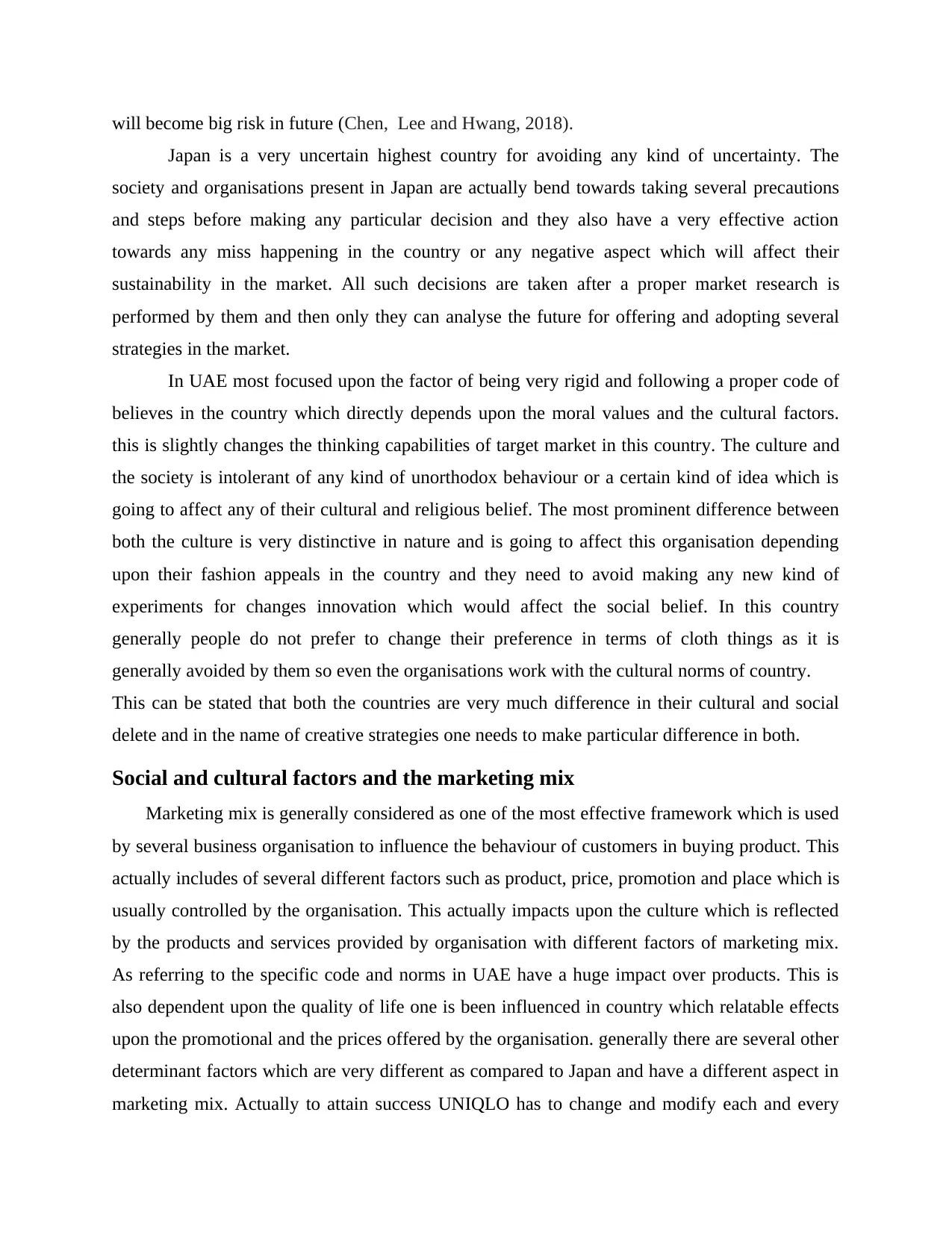
will become big risk in future (Chen, Lee and Hwang, 2018).
Japan is a very uncertain highest country for avoiding any kind of uncertainty. The
society and organisations present in Japan are actually bend towards taking several precautions
and steps before making any particular decision and they also have a very effective action
towards any miss happening in the country or any negative aspect which will affect their
sustainability in the market. All such decisions are taken after a proper market research is
performed by them and then only they can analyse the future for offering and adopting several
strategies in the market.
In UAE most focused upon the factor of being very rigid and following a proper code of
believes in the country which directly depends upon the moral values and the cultural factors.
this is slightly changes the thinking capabilities of target market in this country. The culture and
the society is intolerant of any kind of unorthodox behaviour or a certain kind of idea which is
going to affect any of their cultural and religious belief. The most prominent difference between
both the culture is very distinctive in nature and is going to affect this organisation depending
upon their fashion appeals in the country and they need to avoid making any new kind of
experiments for changes innovation which would affect the social belief. In this country
generally people do not prefer to change their preference in terms of cloth things as it is
generally avoided by them so even the organisations work with the cultural norms of country.
This can be stated that both the countries are very much difference in their cultural and social
delete and in the name of creative strategies one needs to make particular difference in both.
Social and cultural factors and the marketing mix
Marketing mix is generally considered as one of the most effective framework which is used
by several business organisation to influence the behaviour of customers in buying product. This
actually includes of several different factors such as product, price, promotion and place which is
usually controlled by the organisation. This actually impacts upon the culture which is reflected
by the products and services provided by organisation with different factors of marketing mix.
As referring to the specific code and norms in UAE have a huge impact over products. This is
also dependent upon the quality of life one is been influenced in country which relatable effects
upon the promotional and the prices offered by the organisation. generally there are several other
determinant factors which are very different as compared to Japan and have a different aspect in
marketing mix. Actually to attain success UNIQLO has to change and modify each and every
Japan is a very uncertain highest country for avoiding any kind of uncertainty. The
society and organisations present in Japan are actually bend towards taking several precautions
and steps before making any particular decision and they also have a very effective action
towards any miss happening in the country or any negative aspect which will affect their
sustainability in the market. All such decisions are taken after a proper market research is
performed by them and then only they can analyse the future for offering and adopting several
strategies in the market.
In UAE most focused upon the factor of being very rigid and following a proper code of
believes in the country which directly depends upon the moral values and the cultural factors.
this is slightly changes the thinking capabilities of target market in this country. The culture and
the society is intolerant of any kind of unorthodox behaviour or a certain kind of idea which is
going to affect any of their cultural and religious belief. The most prominent difference between
both the culture is very distinctive in nature and is going to affect this organisation depending
upon their fashion appeals in the country and they need to avoid making any new kind of
experiments for changes innovation which would affect the social belief. In this country
generally people do not prefer to change their preference in terms of cloth things as it is
generally avoided by them so even the organisations work with the cultural norms of country.
This can be stated that both the countries are very much difference in their cultural and social
delete and in the name of creative strategies one needs to make particular difference in both.
Social and cultural factors and the marketing mix
Marketing mix is generally considered as one of the most effective framework which is used
by several business organisation to influence the behaviour of customers in buying product. This
actually includes of several different factors such as product, price, promotion and place which is
usually controlled by the organisation. This actually impacts upon the culture which is reflected
by the products and services provided by organisation with different factors of marketing mix.
As referring to the specific code and norms in UAE have a huge impact over products. This is
also dependent upon the quality of life one is been influenced in country which relatable effects
upon the promotional and the prices offered by the organisation. generally there are several other
determinant factors which are very different as compared to Japan and have a different aspect in
marketing mix. Actually to attain success UNIQLO has to change and modify each and every
⊘ This is a preview!⊘
Do you want full access?
Subscribe today to unlock all pages.

Trusted by 1+ million students worldwide

factor as per the UAE norms and then only they can establish their business successfully. All of
these factors are briefly described below:
Product: UNIQLO can target the actual population of UAE by launching ethnic wear.
This is actually decided by the management which will trend to explore the new country. We
have to look up on several trends and prevailing actions which usually restrain the woman in
wearing any kinds of extensive Western wears. This actually provides a proper assistance for
them to have an appealing prospective in UAE and establish a very particular and strong image
as a brand.
Price: reprise management in this organisation is dependent upon the offering in ethnic
wear which will be hired and prices has the main target market is for the classy people who are
actually seeking high standard and quality in UAE.
Promotion: this is one factor which is actually done by the company in suggesting to be
height in promoting their business and while expanding in UAE. This company will actually use
digitalization as the biggest promotional technique which will be combined with the QR
scanning and many other seasonal discounts which will be providing several customers use
amount of benefit. this will actually be helpful for organisation in seeking attention from an large
group of people in UAE in UNIQLO.
Place: since the promotion will be done from a height proportional techniques the
organisation will start selling their products and services even with online services which are
easier access to customers and with the outlets there will be a minimum amount of attracting
customers and influencing them in purchasing this cultural ethnic wear (Qin, Kim and Tan,
2018).
Process: UNIQLO has constantly been evolving in the matter of digitalization and
nutrients and have set up their procedures so that huge amount of audience and attractive and
appealed towards their product and the firm will be able to create a very positive image in the
market.
Physical evidence: several stores actually tend to be physical evidence of representing the
organisation and the ethnic fashion which is being available to all the customers. This is the most
easy access to the organisation and can actually draw attention from several buyers and can
inflate or degrade the revenues at a very fair price.
People: UNIQLO believes their employees to be done in acids and the one element which
these factors are briefly described below:
Product: UNIQLO can target the actual population of UAE by launching ethnic wear.
This is actually decided by the management which will trend to explore the new country. We
have to look up on several trends and prevailing actions which usually restrain the woman in
wearing any kinds of extensive Western wears. This actually provides a proper assistance for
them to have an appealing prospective in UAE and establish a very particular and strong image
as a brand.
Price: reprise management in this organisation is dependent upon the offering in ethnic
wear which will be hired and prices has the main target market is for the classy people who are
actually seeking high standard and quality in UAE.
Promotion: this is one factor which is actually done by the company in suggesting to be
height in promoting their business and while expanding in UAE. This company will actually use
digitalization as the biggest promotional technique which will be combined with the QR
scanning and many other seasonal discounts which will be providing several customers use
amount of benefit. this will actually be helpful for organisation in seeking attention from an large
group of people in UAE in UNIQLO.
Place: since the promotion will be done from a height proportional techniques the
organisation will start selling their products and services even with online services which are
easier access to customers and with the outlets there will be a minimum amount of attracting
customers and influencing them in purchasing this cultural ethnic wear (Qin, Kim and Tan,
2018).
Process: UNIQLO has constantly been evolving in the matter of digitalization and
nutrients and have set up their procedures so that huge amount of audience and attractive and
appealed towards their product and the firm will be able to create a very positive image in the
market.
Physical evidence: several stores actually tend to be physical evidence of representing the
organisation and the ethnic fashion which is being available to all the customers. This is the most
easy access to the organisation and can actually draw attention from several buyers and can
inflate or degrade the revenues at a very fair price.
People: UNIQLO believes their employees to be done in acids and the one element which
Paraphrase This Document
Need a fresh take? Get an instant paraphrase of this document with our AI Paraphraser
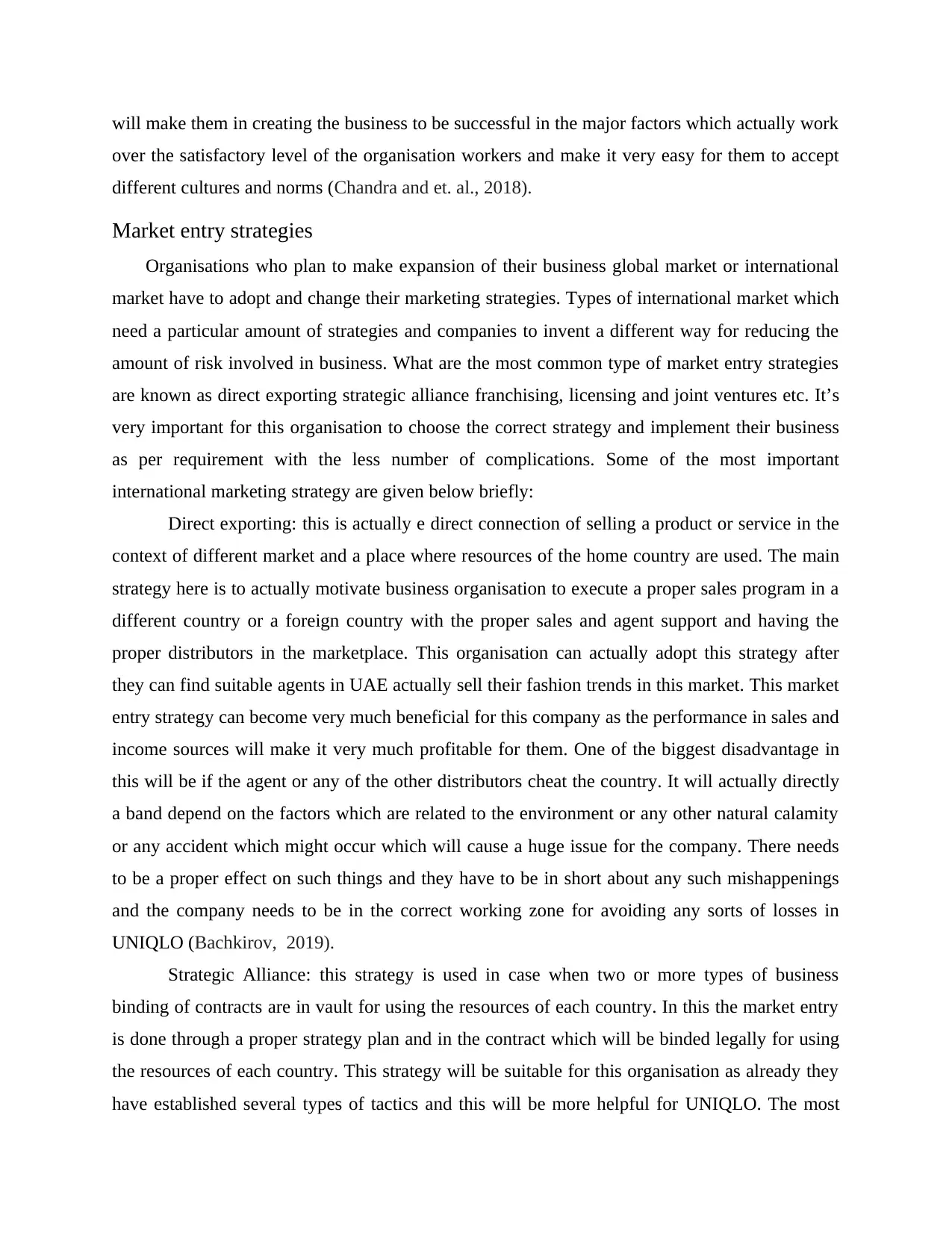
will make them in creating the business to be successful in the major factors which actually work
over the satisfactory level of the organisation workers and make it very easy for them to accept
different cultures and norms (Chandra and et. al., 2018).
Market entry strategies
Organisations who plan to make expansion of their business global market or international
market have to adopt and change their marketing strategies. Types of international market which
need a particular amount of strategies and companies to invent a different way for reducing the
amount of risk involved in business. What are the most common type of market entry strategies
are known as direct exporting strategic alliance franchising, licensing and joint ventures etc. It’s
very important for this organisation to choose the correct strategy and implement their business
as per requirement with the less number of complications. Some of the most important
international marketing strategy are given below briefly:
Direct exporting: this is actually e direct connection of selling a product or service in the
context of different market and a place where resources of the home country are used. The main
strategy here is to actually motivate business organisation to execute a proper sales program in a
different country or a foreign country with the proper sales and agent support and having the
proper distributors in the marketplace. This organisation can actually adopt this strategy after
they can find suitable agents in UAE actually sell their fashion trends in this market. This market
entry strategy can become very much beneficial for this company as the performance in sales and
income sources will make it very much profitable for them. One of the biggest disadvantage in
this will be if the agent or any of the other distributors cheat the country. It will actually directly
a band depend on the factors which are related to the environment or any other natural calamity
or any accident which might occur which will cause a huge issue for the company. There needs
to be a proper effect on such things and they have to be in short about any such mishappenings
and the company needs to be in the correct working zone for avoiding any sorts of losses in
UNIQLO (Bachkirov, 2019).
Strategic Alliance: this strategy is used in case when two or more types of business
binding of contracts are in vault for using the resources of each country. In this the market entry
is done through a proper strategy plan and in the contract which will be binded legally for using
the resources of each country. This strategy will be suitable for this organisation as already they
have established several types of tactics and this will be more helpful for UNIQLO. The most
over the satisfactory level of the organisation workers and make it very easy for them to accept
different cultures and norms (Chandra and et. al., 2018).
Market entry strategies
Organisations who plan to make expansion of their business global market or international
market have to adopt and change their marketing strategies. Types of international market which
need a particular amount of strategies and companies to invent a different way for reducing the
amount of risk involved in business. What are the most common type of market entry strategies
are known as direct exporting strategic alliance franchising, licensing and joint ventures etc. It’s
very important for this organisation to choose the correct strategy and implement their business
as per requirement with the less number of complications. Some of the most important
international marketing strategy are given below briefly:
Direct exporting: this is actually e direct connection of selling a product or service in the
context of different market and a place where resources of the home country are used. The main
strategy here is to actually motivate business organisation to execute a proper sales program in a
different country or a foreign country with the proper sales and agent support and having the
proper distributors in the marketplace. This organisation can actually adopt this strategy after
they can find suitable agents in UAE actually sell their fashion trends in this market. This market
entry strategy can become very much beneficial for this company as the performance in sales and
income sources will make it very much profitable for them. One of the biggest disadvantage in
this will be if the agent or any of the other distributors cheat the country. It will actually directly
a band depend on the factors which are related to the environment or any other natural calamity
or any accident which might occur which will cause a huge issue for the company. There needs
to be a proper effect on such things and they have to be in short about any such mishappenings
and the company needs to be in the correct working zone for avoiding any sorts of losses in
UNIQLO (Bachkirov, 2019).
Strategic Alliance: this strategy is used in case when two or more types of business
binding of contracts are in vault for using the resources of each country. In this the market entry
is done through a proper strategy plan and in the contract which will be binded legally for using
the resources of each country. This strategy will be suitable for this organisation as already they
have established several types of tactics and this will be more helpful for UNIQLO. The most
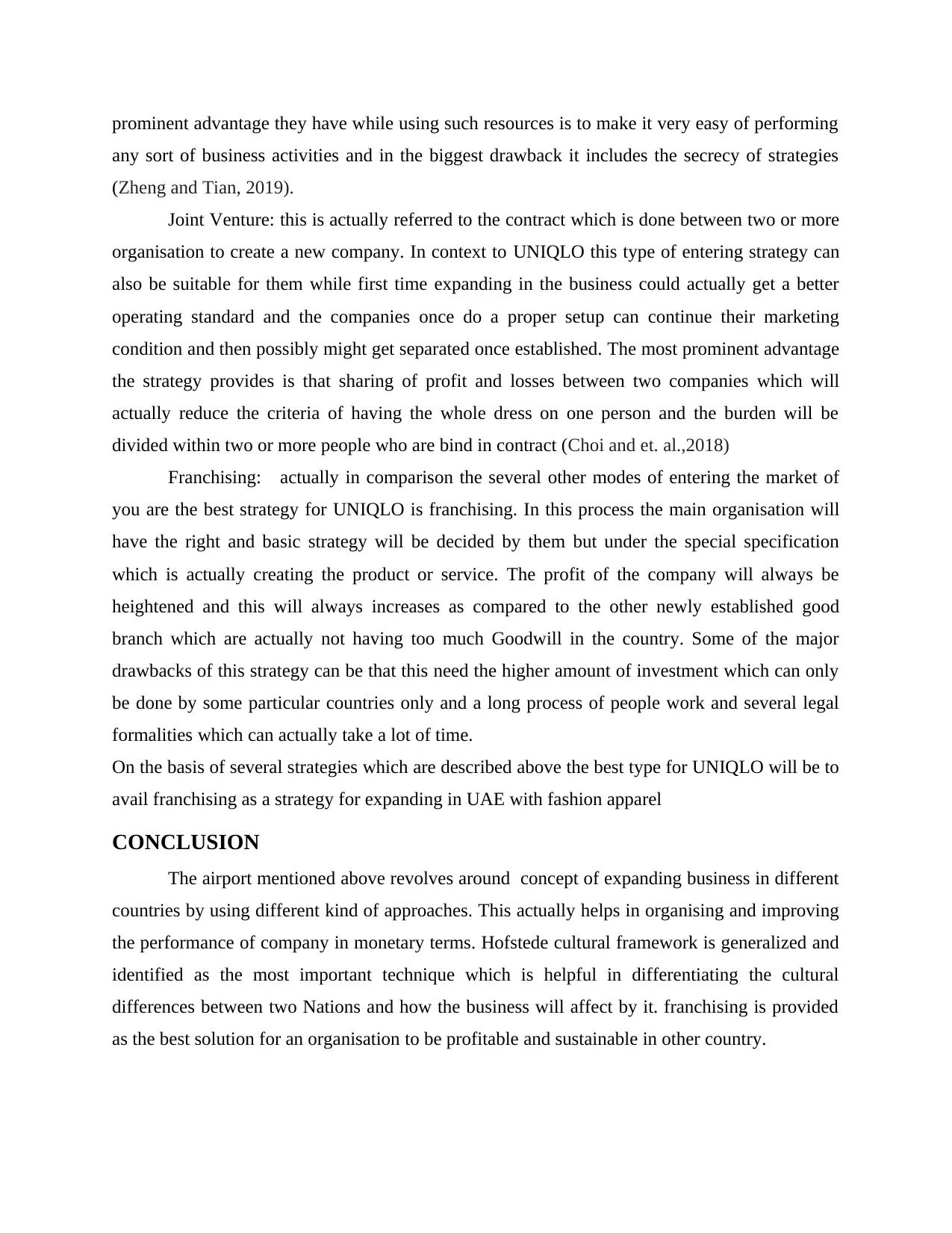
prominent advantage they have while using such resources is to make it very easy of performing
any sort of business activities and in the biggest drawback it includes the secrecy of strategies
(Zheng and Tian, 2019).
Joint Venture: this is actually referred to the contract which is done between two or more
organisation to create a new company. In context to UNIQLO this type of entering strategy can
also be suitable for them while first time expanding in the business could actually get a better
operating standard and the companies once do a proper setup can continue their marketing
condition and then possibly might get separated once established. The most prominent advantage
the strategy provides is that sharing of profit and losses between two companies which will
actually reduce the criteria of having the whole dress on one person and the burden will be
divided within two or more people who are bind in contract (Choi and et. al.,2018)
Franchising: actually in comparison the several other modes of entering the market of
you are the best strategy for UNIQLO is franchising. In this process the main organisation will
have the right and basic strategy will be decided by them but under the special specification
which is actually creating the product or service. The profit of the company will always be
heightened and this will always increases as compared to the other newly established good
branch which are actually not having too much Goodwill in the country. Some of the major
drawbacks of this strategy can be that this need the higher amount of investment which can only
be done by some particular countries only and a long process of people work and several legal
formalities which can actually take a lot of time.
On the basis of several strategies which are described above the best type for UNIQLO will be to
avail franchising as a strategy for expanding in UAE with fashion apparel
CONCLUSION
The airport mentioned above revolves around concept of expanding business in different
countries by using different kind of approaches. This actually helps in organising and improving
the performance of company in monetary terms. Hofstede cultural framework is generalized and
identified as the most important technique which is helpful in differentiating the cultural
differences between two Nations and how the business will affect by it. franchising is provided
as the best solution for an organisation to be profitable and sustainable in other country.
any sort of business activities and in the biggest drawback it includes the secrecy of strategies
(Zheng and Tian, 2019).
Joint Venture: this is actually referred to the contract which is done between two or more
organisation to create a new company. In context to UNIQLO this type of entering strategy can
also be suitable for them while first time expanding in the business could actually get a better
operating standard and the companies once do a proper setup can continue their marketing
condition and then possibly might get separated once established. The most prominent advantage
the strategy provides is that sharing of profit and losses between two companies which will
actually reduce the criteria of having the whole dress on one person and the burden will be
divided within two or more people who are bind in contract (Choi and et. al.,2018)
Franchising: actually in comparison the several other modes of entering the market of
you are the best strategy for UNIQLO is franchising. In this process the main organisation will
have the right and basic strategy will be decided by them but under the special specification
which is actually creating the product or service. The profit of the company will always be
heightened and this will always increases as compared to the other newly established good
branch which are actually not having too much Goodwill in the country. Some of the major
drawbacks of this strategy can be that this need the higher amount of investment which can only
be done by some particular countries only and a long process of people work and several legal
formalities which can actually take a lot of time.
On the basis of several strategies which are described above the best type for UNIQLO will be to
avail franchising as a strategy for expanding in UAE with fashion apparel
CONCLUSION
The airport mentioned above revolves around concept of expanding business in different
countries by using different kind of approaches. This actually helps in organising and improving
the performance of company in monetary terms. Hofstede cultural framework is generalized and
identified as the most important technique which is helpful in differentiating the cultural
differences between two Nations and how the business will affect by it. franchising is provided
as the best solution for an organisation to be profitable and sustainable in other country.
⊘ This is a preview!⊘
Do you want full access?
Subscribe today to unlock all pages.

Trusted by 1+ million students worldwide
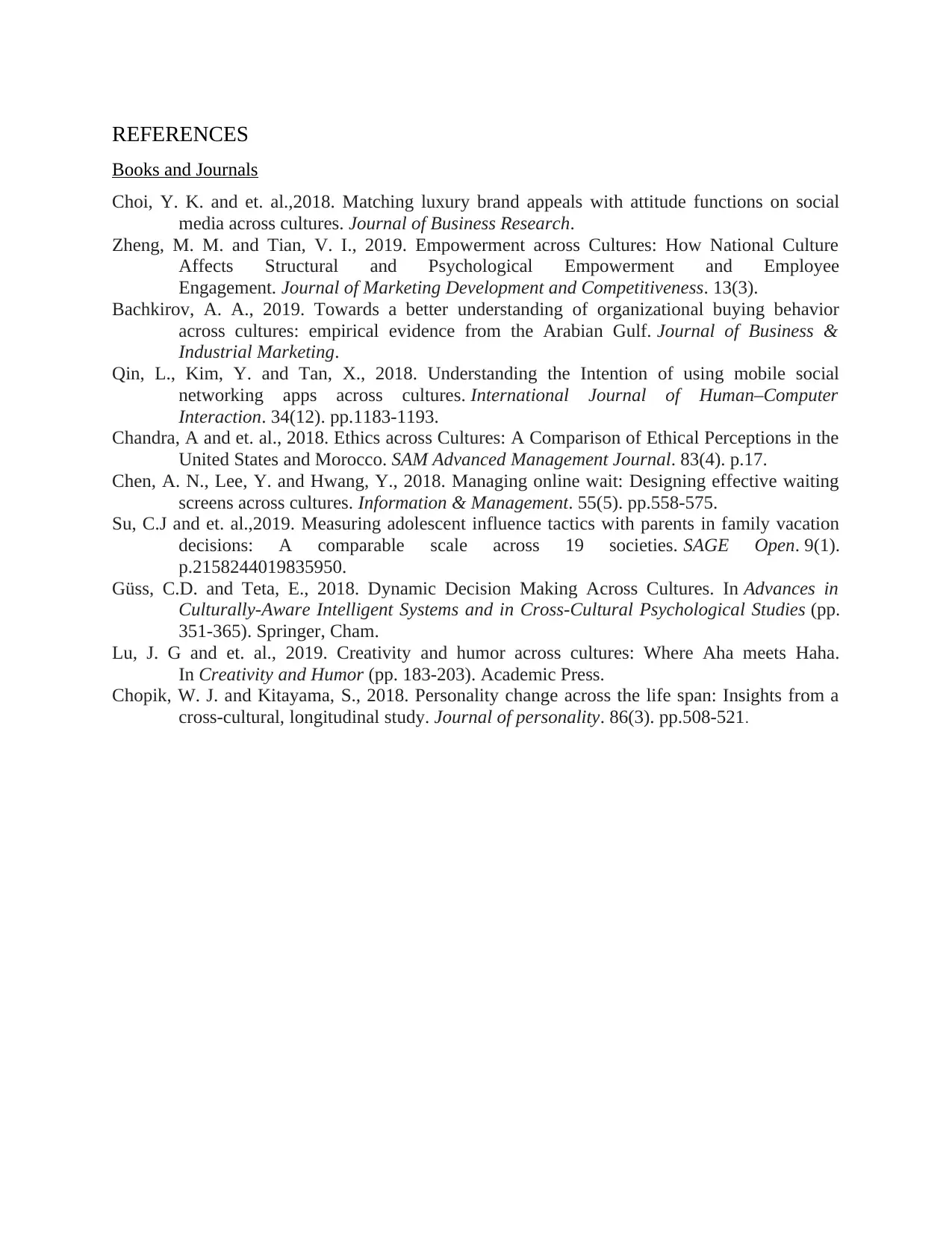
REFERENCES
Books and Journals
Choi, Y. K. and et. al.,2018. Matching luxury brand appeals with attitude functions on social
media across cultures. Journal of Business Research.
Zheng, M. M. and Tian, V. I., 2019. Empowerment across Cultures: How National Culture
Affects Structural and Psychological Empowerment and Employee
Engagement. Journal of Marketing Development and Competitiveness. 13(3).
Bachkirov, A. A., 2019. Towards a better understanding of organizational buying behavior
across cultures: empirical evidence from the Arabian Gulf. Journal of Business &
Industrial Marketing.
Qin, L., Kim, Y. and Tan, X., 2018. Understanding the Intention of using mobile social
networking apps across cultures. International Journal of Human–Computer
Interaction. 34(12). pp.1183-1193.
Chandra, A and et. al., 2018. Ethics across Cultures: A Comparison of Ethical Perceptions in the
United States and Morocco. SAM Advanced Management Journal. 83(4). p.17.
Chen, A. N., Lee, Y. and Hwang, Y., 2018. Managing online wait: Designing effective waiting
screens across cultures. Information & Management. 55(5). pp.558-575.
Su, C.J and et. al.,2019. Measuring adolescent influence tactics with parents in family vacation
decisions: A comparable scale across 19 societies. SAGE Open. 9(1).
p.2158244019835950.
Güss, C.D. and Teta, E., 2018. Dynamic Decision Making Across Cultures. In Advances in
Culturally-Aware Intelligent Systems and in Cross-Cultural Psychological Studies (pp.
351-365). Springer, Cham.
Lu, J. G and et. al., 2019. Creativity and humor across cultures: Where Aha meets Haha.
In Creativity and Humor (pp. 183-203). Academic Press.
Chopik, W. J. and Kitayama, S., 2018. Personality change across the life span: Insights from a
cross‐cultural, longitudinal study. Journal of personality. 86(3). pp.508-521.
Books and Journals
Choi, Y. K. and et. al.,2018. Matching luxury brand appeals with attitude functions on social
media across cultures. Journal of Business Research.
Zheng, M. M. and Tian, V. I., 2019. Empowerment across Cultures: How National Culture
Affects Structural and Psychological Empowerment and Employee
Engagement. Journal of Marketing Development and Competitiveness. 13(3).
Bachkirov, A. A., 2019. Towards a better understanding of organizational buying behavior
across cultures: empirical evidence from the Arabian Gulf. Journal of Business &
Industrial Marketing.
Qin, L., Kim, Y. and Tan, X., 2018. Understanding the Intention of using mobile social
networking apps across cultures. International Journal of Human–Computer
Interaction. 34(12). pp.1183-1193.
Chandra, A and et. al., 2018. Ethics across Cultures: A Comparison of Ethical Perceptions in the
United States and Morocco. SAM Advanced Management Journal. 83(4). p.17.
Chen, A. N., Lee, Y. and Hwang, Y., 2018. Managing online wait: Designing effective waiting
screens across cultures. Information & Management. 55(5). pp.558-575.
Su, C.J and et. al.,2019. Measuring adolescent influence tactics with parents in family vacation
decisions: A comparable scale across 19 societies. SAGE Open. 9(1).
p.2158244019835950.
Güss, C.D. and Teta, E., 2018. Dynamic Decision Making Across Cultures. In Advances in
Culturally-Aware Intelligent Systems and in Cross-Cultural Psychological Studies (pp.
351-365). Springer, Cham.
Lu, J. G and et. al., 2019. Creativity and humor across cultures: Where Aha meets Haha.
In Creativity and Humor (pp. 183-203). Academic Press.
Chopik, W. J. and Kitayama, S., 2018. Personality change across the life span: Insights from a
cross‐cultural, longitudinal study. Journal of personality. 86(3). pp.508-521.
Paraphrase This Document
Need a fresh take? Get an instant paraphrase of this document with our AI Paraphraser


⊘ This is a preview!⊘
Do you want full access?
Subscribe today to unlock all pages.

Trusted by 1+ million students worldwide
1 out of 12
Related Documents
Your All-in-One AI-Powered Toolkit for Academic Success.
+13062052269
info@desklib.com
Available 24*7 on WhatsApp / Email
![[object Object]](/_next/static/media/star-bottom.7253800d.svg)
Unlock your academic potential
Copyright © 2020–2025 A2Z Services. All Rights Reserved. Developed and managed by ZUCOL.





